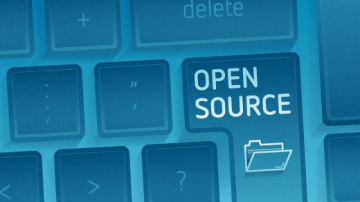Stuck indoors like most of the rest of the world, a group of Opensource.com editors and correspondents—Seth Kenlon, Matt Broberg, Alan Formy-Duval, Jessica Cherry, and Chris Hermansen—decided to use their far-flung locations and variable-quality internet connections to try out several open source video-conferencing solutions.
Our investigation was motivated by two main issues:
- Concern over recent reports about security risks in closed-source video-conferencing systems, including unwanted attendees interrupting meetings and stealthy sharing of attendees' information
- The desire for a comparative review of the capabilities and performance of open source conference software and platforms
Here's what we found.
Jitsi
Jitsi proved to be a robust and powerful platform, requiring no registration or download, but providing plenty of features to manage a group chat and diagnose connection health. The project itself is healthy, too, having been acquired by 8x8 in 2018, which has proven to be a good custodian of the open source codebase, with a focus on new features, usability, and reliability.
One of its unique features is that it allows you to create channel names, so instead of a long, complex URL (like example.com/7ab9ecd340aaed_9fe2ac588466), you can invite someone to meet.jit.si/Seth-Chris-Chat23 (or anything meaningful or easy to recall). Even the default URL strings are sane: they tend to be somewhat long, but they're built using common words, so they're easy to type if you don't happen to have a clickable link handy.
These are the features we tested, but there are many more (too many to list) with others in the works (for instance, a filter to blur your background was in beta when we tested):
- Browser, desktop app, mobile app
- Option to record calls
- Windowed or full screen
- Grid view (unlimited, with up to 25 onscreen at a time)
- Screen share
- Share and present videos from YouTube
- Take control of mouse remotely (desktop app only)
- Easy audio and video input switching as needed
- Adjustable video quality
- Mute all
- Kick participants
- Flip your own image
- Encryption
Chris Hermansen: I really appreciated the high quality and excellent synchronization of video and audio in the Jitsi platform and may give it a try for group chats with colleagues.
Jessica Cherry: This one works well and does have several options that are amazing, like screengrab, kicking people from the call, muting, and password control, plus a phone app for your less technical friends. I don't like that password control is based on the first person in. It's worth noting that some features are only available with the desktop version of the software.
Alan Formy-Duval: Simple to log in and get underway. It's a plus that it's available for deployment in a private or personal server, if the user chooses.
Signal
Signal is an ideal replacement for personal chat applications in features, function, and security. It is designed for privacy and provides end-to-end encryption, and it is completely open source. It's gotten many new features lately, but when we tested it, it was primarily designed for mobile, and its desktop client was limited to text chat only.
Signal wasn't a group-chat solution when we originally wrote this article, so we were unable to test it as a group. However, Seth and Chris have used it before with great success. The process is smooth and direct; you can switch from a text chat to a video chat quickly and easily. Because Signal uses your mobile phone number as your identifier, it's easy to invite contacts who are already in your social circle.
The video-chat function offers just the basics: a screen with your image as the inset. All input and output are managed by your device, so if you switch your microphone from the phone receiver to a Bluetooth headset, Signal follows along.
There was no user management during the video chat because, as a one-to-one conversation, there's no sense of a moderator. It's face-to-face chat, and everything you'd expect from a "normal" phone call is what you have available in Signal, with the addition of video. The text chat is full of all the usual features in a modern mobile chat app (e.g., text, emoji, and so on). Features include:
- Mobile app only (for video)
- One-on-one chat only
- Easy audio and video input switching managed by the operating system
- Encryption
Since this article was originally published, Signal has gained group video chat capabilities, and the desktop client has gained video and audio chat buttons.
Chris Hermansen: I'll continue to use Signal for person-to-person when I have the choice.
Jessica Cherry: This app is great for group text but not for voice conferences. The support for video is only one-on-one, so this isn't suitable for use with larger groups (unless you only need a group chat over text).
Seth Kenlon: Signal is a great app and should be the default mobile chat application for all devices. It's easy to use, encrypted, and versatile. Why would anyone NOT use this over any other option?
P2p.chat
P2p.chat is a peer-to-peer chat application requiring no intermediary server, aside from a signalhub to coordinate clients. It uses WebRTC to power all communications between peers, with each channel creating a unique WebRTC Swarm. This eliminates the fear of man-in-the-middle attacks and ensures all video is encrypted end-to-end.
As with Jitsi, you can craft a custom URL that is easier to recall and type.
The application is minimal. It is very much just a video gateway from one device to another. It doesn't have advanced chatroom features, so if you're moderating a big group conference, you can't mute attendees nor kick someone from the meeting. You can mute your own audio and video or leave the channel, and that's the extent of its dashboard features.
Its advantage, however, is pretty clear: direct video chats with no intervening server. This is a powerful and direct feature. Other features include:
- Browser-based only
- Peer-to-peer, with no intermediary server
- Grid view
- Audio and video input switching is managed by your browser and operating system. If your browser fails to detect a change in input, you may have to drop and rejoin the channel.
- Encryption
Seth Kenlon: Now that I know about this technology, I'll use it for quick one-to-one calls with people not on Signal. I love the freedom from intermediary services, and generally, I have no desperate need for moderator features.
Nextcloud Talk
Nextcloud is an excellent groupware framework with dozens of plugins to augment its existing collaborative features. The Talk plugin (code-named Spreed) adds text and video chat to your Nextcloud instance, so your userbase can quickly and easily communicate while working.
To start a call, you must first start a chat. To start a chat, you must have a second Nextcloud user to chat with. That seems obvious, but it means that any chat session, even one you intend to use with an outside user (a "guest" in Nextcloud terminology), must start with a Nextcloud user, even if it's just a dummy account. We didn't understand this until after we were finished testing for this article, though, so we were unable to establish a connection through Nextcloud.
After we finished testing, Seth persisted and discovered the proper workflow:
- Create a dummy account in Nextcloud
- Start a chat with the dummy account
- Start a call with the dummy account
- Get a shareable link to the call
- Send the link to friends not on Nextcloud
After that, calls went well. There are some advanced features, but it's mostly a minimal interface, probably meant as a quick and easy way to interact with a collaborator and fellow Nextcloud denizen rather than for complex video conferencing. Features include:
- Browser and mobile apps
- Audio and video input switching is managed by your browser and operating system. If your browser fails to detect a change in input, you may have to drop and rejoin the call.
- Screen sharing
- Kick participants
- Encryption (in fact, all calls fail without HTTPS)
Seth Kenlon: Now that I have it working, I'll likely use it for family and friends who have accounts on my Nextcloud install, but not for external chats.
BigBlueButton
Designed for classrooms, conferences, and webinars, BigBlueButton is the most complex and flexible video-conference software we tested. It has all the features you need to manage large groups of participants, allowing you to mute and unmute, create on-demand breakout rooms for side conversations, kick unruly users, and even close the virtual doors to your channel by requiring explicit approval for anyone to join the call. Participants have a lot of power, too, where appropriate: for instance, they can raise their (virtual) hand or set their status (confused, clear, etc.) to communicate with the presenter.
BigBlueButton has so many features, so you should learn it before using it. That way, you can hone in on the features you intend to use and get good at accessing them quickly and fluidly. Unlike p2p.chat or Signal, BigBlueButton is intended to be hosted. You can purchase hosting, or you can install it yourself (or have your IT staff install it for you). You can try it out for 30 minutes at a time on the demo site, but the expectation is that you have access to a dedicated instance.
Features:
- Browser app
- Option to record calls
- Windowed or full screen
- Grid view
- Screen share to present materials
- Collaborative whiteboard
- Easy audio and video input switching as needed
- Adjustable video quality
- Mute all
- Kick participants
- Block users from joining
- For participants only: raise hand, set status
- Test audio and video prior to joining channel
- Encryption
Seth Kenlon: I've introduced BigBlueButton to a few educators I know, and they're very excited about it. Were I to participate in a virtual conference, this is the software I'd want to use because audience participation is important for my presentations.
Jessica Cherry: There are many great reasons to use this, but it's obviously directed towards either a meeting platform, where a project needs to be put together by a team, or someone teaching a class. It has features those use cases would require: screen share, screen control, moderator abilities within chat, room recording, moderator ability to allow people into the room (great security, in my personal opinion), and the ability to change moderator if a party member needs to leave. The best part, in my opinion, was to start a meeting you just log in and click the big blue start button. I didn't like that video and audio was initialized once when you enter the room, with no easy way to change inputs later, aside from leaving the meeting and then rejoining.
Runner-up: Jami
Formerly known as GNU Ring, Jami is a Session Initiation Protocol (SIP) bridge as well as a peer-to-peer video- and text-chat application. Seth and Alan have used it previously for one-on-one meetings with success. However, when we were testing for this article, we couldn't install it successfully nor connect—even as a duo, much less as a group. We tested it on a variety of operating systems and devices but ultimately had to abandon Jami as an option due to instability.
Jami is a promising application with support for a wide variety of platforms. It's something to look at after it's had a little more time to develop.
Conclusions
Regardless of which solution you choose, we're clearly past the tipping point of open source communication. There are several great options, so try one on your next call, and get off those proprietary and centralized (and probably insecure) chat applications! Next time someone invites you to a call, make a counter offer with an easy-to-remember Jitsi or p2p.chat URL or just your phone number for a Signal chat.















5 Comments